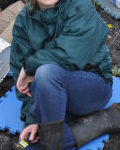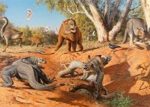Research
Battery-switching device promises more road time for Tesla, Leaf drivers
Nov. 28, 2017—Read the Vanderbilt Engineering story here. Nissan Leafs, which go about 107 miles on a charge, often don’t graduate beyond commuter car status due to battery-life worries. The mass-market, standard Tesla Model 3 can travel double that distance, which is still limiting on long road trips. Both batteries could work about 50 percent longer with...
Ultrathin device harvests electricity from human motion
Jul. 25, 2017—Imagine slipping into a jacket, shirt or skirt that powers your cell phone, fitness tracker and other personal electronic devices as you walk, wave and even when you are sitting down. A new, ultrathin energy harvesting system developed at Vanderbilt University’s Nanomaterials and Energy Devices Laboratory has the potential to do just that. Based on battery technology...
TIPs funding awarded to 15 innovative interdisciplinary projects
Jul. 18, 2017—The 2017 recipients of Vanderbilt University’s Trans-Institutional Programs (TIPs) initiative,15 exciting interdisciplinary concepts, include an initiative related to understanding climate change effects. These research projects bring together more than 140 faculty members with graduate and undergraduate students from all 10 schools and colleges, creating multifaceted teams to approach complex challenges. “This innovative, cross-campus approach that creates...
Web-based tool will help government realistically plan for climate change
Jun. 5, 2017—Read the Research News @ Vanderbilt story here. Life beside the Mississippi River always came with some uncertainty about the safety of homes, crops and city streets. Residents looked at flood maps based on historical data and chose their sites, built their levies and bridge footings and kept a wary eye on the river stages....
Climate change took away ancient animals’ food supply; holds implications for today’s wildlife
Jun. 5, 2017—Read the Research News @ Vanderbilt story here. During the last Ice Age, Australia, Tasmania and New Guinea formed a single landmass. It was a strange and often hostile place populated by a bizarre cast of giant animals – massive kangaroos and others claimed in a global mass extinction 30,000 years ago. Researchers argue what...
Expert: Private industry, better messaging can help overcome damage from Paris withdrawal
Jun. 5, 2017—Read the Research News @ Vanderbilt story here. President Donald Trump’s announcement on Thursday that the U.S. will withdraw from the Paris Climate Agreement phases out U.S. commitments to achieve carbon reduction targets and make financial contributions to slow climate change. It was a move environmentalists found disappointing, at best. But Vanderbilt University law and...
Climate Science Myth Busters Seminar
Apr. 10, 2017—Join the Department of Civil & Environmental Engineering April 12 at 3:10pm in Featheringill Hall 134 for a seminar by Dr. Jonathan Gilligan: Climate Science Myth Busters. There is a lot of misinformation out there regarding climate change. Dr. Jonathan Gilligan will present on the state of climate science and answer questions such as: Is...
Gilligan, Vandenbergh win Morrison Prize for climate change article
Feb. 21, 2017—Read the Vanderbilt News story here. Research examining the role that private governance can play in bypassing government gridlock on climate change has earned a pair of Vanderbilt University professors this year’s $10,000 Morrison Prize, which recognizes the most impactful sustainability-related legal academic article published in North America during the previous year. Michael P. Vandenbergh...
Four in civil engineering elected to American Academy of Environmental Engineers and Scientists
Feb. 2, 2017—Read the School of Engineering story here. Three Vanderbilt civil engineering professors and one senior research scientist who are nationally recognized experts in environmental sustainability and hazardous waste management have been elected for membership in the American Academy of Environmental Engineers and Scientists and recognized as board certified environmental scientists. Craig Philip, George Hornberger, Doug...
Climate change helped kill off super-sized Ice Age animals in Australia
Jan. 27, 2017—Read the Research News at Vanderbilt story here. During the last Ice Age, Australia, Tasmania and New Guinea formed a single landmass, called Sahul. It was a strange and often hostile place populated by a bizarre cast of giant animals. There were 500-pound kangaroos, marsupial tapirs the size of horses and wombat-like creatures the size...








